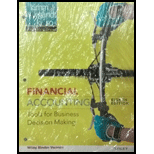
Bundle: Financial Accounting: Tools for Business Decision Making 8e Binder Ready Version + WileyPLUS Registration Code
8th Edition
ISBN: 9781119221647
Author: Paul D. Kimmel
Publisher: Wiley (WileyPLUS Products)
expand_more
expand_more
format_list_bulleted
Question
Chapter 10, Problem 20Q
To determine
Liquidity ratios
Liquidity ratios measure the short-term capacity of a company to pay its maturing obligations, and to meet unanticipated requirements for cash. Liquidity ratios are
Solvency ratios
Solvency ratios measure the capacity of a company to sustain over a long period of time. Solvency ratios are debt to assets ratio, time interest earned ratio, and debt to equity ratio, and more.
To Ascertain: If the saying of ES that the
Expert Solution & Answer
Want to see the full answer?
Check out a sample textbook solution
Students have asked these similar questions
Westwood Components incurs $18 in variable costs and $6 in allocated fixed costs to produce a product that sells for $32 per unit. A customer in Mexico offers to purchase 2,000 units at $21 each. Westwood Components has excess capacity and can handle the additional production. What effect will acceptance of the offer have on net income?
Please give me answer with accounting question
Get correct answer with general accounting question
Chapter 10 Solutions
Bundle: Financial Accounting: Tools for Business Decision Making 8e Binder Ready Version + WileyPLUS Registration Code
Ch. 10 - Prob. 1QCh. 10 - Prob. 2QCh. 10 - Prob. 3QCh. 10 - Prob. 4QCh. 10 - Prob. 5QCh. 10 - (a) Identify three taxes commonly paid by...Ch. 10 - Prob. 7QCh. 10 - Prob. 8QCh. 10 - Contrast these types of bonds: (a) Secured and...Ch. 10 - Prob. 10Q
Ch. 10 - Prob. 11QCh. 10 - Prob. 12QCh. 10 - Prob. 13QCh. 10 - Lee and Jay are discussing how the market price of...Ch. 10 - Prob. 15QCh. 10 - Prob. 16QCh. 10 - Prob. 17QCh. 10 - Prob. 18QCh. 10 - Prob. 19QCh. 10 - Prob. 20QCh. 10 - Prob. 21QCh. 10 - Prob. 22QCh. 10 - Prob. 23QCh. 10 - Prob. 24QCh. 10 - Prob. 25QCh. 10 - Prob. 26QCh. 10 - Prob. 27QCh. 10 - Prob. 28QCh. 10 - Prob. 29QCh. 10 - Prob. 30QCh. 10 - Prob. 31QCh. 10 - Prob. 10.1BECh. 10 - Prob. 10.2BECh. 10 - Prob. 10.3BECh. 10 - Prob. 10.4BECh. 10 - Prob. 10.5BECh. 10 - Prob. 10.6BECh. 10 - Prob. 10.7BECh. 10 - Prob. 10.8BECh. 10 - Prob. 10.9BECh. 10 - Prob. 10.10BECh. 10 - Prob. 10.11BECh. 10 - Prob. 10.12BECh. 10 - Prob. 10.13BECh. 10 - Prob. 10.14BECh. 10 - Prob. 10.15BECh. 10 - Prob. 10.16BECh. 10 - Prob. 10.17BECh. 10 - Prob. 10.18BECh. 10 - Prob. 10.19BECh. 10 - Prob. 10.1ADIECh. 10 - Prob. 10.1BDIECh. 10 - State whether each of the following statements is...Ch. 10 - Prob. 10.3ADIECh. 10 - Prob. 10.3BDIECh. 10 - Prob. 10.4DIECh. 10 - Prob. 10.1ECh. 10 - Prob. 10.2ECh. 10 - Prob. 10.3ECh. 10 - Prob. 10.4ECh. 10 - Prob. 10.5ECh. 10 - Prob. 10.6ECh. 10 - Prob. 10.7ECh. 10 - Prob. 10.8ECh. 10 - Prob. 10.9ECh. 10 - Prob. 10.10ECh. 10 - Prob. 10.11ECh. 10 - Prob. 10.12ECh. 10 - Prob. 10.13ECh. 10 - Prob. 10.14ECh. 10 - Prob. 10.15ECh. 10 - Prob. 10.16ECh. 10 - Prob. 10.17ECh. 10 - Prob. 10.18ECh. 10 - Prob. 10.19ECh. 10 - Prob. 10.20ECh. 10 - Prob. 10.21ECh. 10 - Prob. 10.22ECh. 10 - Prob. 10.23ECh. 10 - Prob. 10.24ECh. 10 - Prob. 10.25ECh. 10 - Prob. 10.1APCh. 10 - Prob. 10.2APCh. 10 - Prob. 10.3APCh. 10 - Prob. 10.4APCh. 10 - Prob. 10.5APCh. 10 - Prob. 10.6APCh. 10 - Prob. 10.7APCh. 10 - Prob. 10.8APCh. 10 - Prob. 10.9APCh. 10 - Prob. 10.10APCh. 10 - Prob. 10.11APCh. 10 - Prob. 10.12APCh. 10 - Prob. 10.13APCh. 10 - Prob. 10.1CACRCh. 10 - Prob. 10.1EYCTCh. 10 - Prob. 10.2EYCTCh. 10 - Prob. 10.3EYCTCh. 10 - Prob. 10.4EYCTCh. 10 - Prob. 10.5EYCTCh. 10 - DECISION-MAKING ACROSS THE ORGANIZATION On January...Ch. 10 - Prob. 10.9EYCTCh. 10 - Prob. 10.10EYCTCh. 10 - Prob. 10.14EYCTCh. 10 - Prob. 10.1IFRSECh. 10 - Prob. 10.2IFRSECh. 10 - Prob. 10.3IFRSECh. 10 - Prob. 10.4IFRSE
Knowledge Booster
Similar questions
- Please help me solve this general accounting problem with the correct financial process.arrow_forwardA machine costs $50,000 with a salvage value of $5,000 and a useful life of 5 years. Calculate the annual depreciation expense using straight-line, double-declining balance, and sum-of-years-digits methods.arrow_forwardDuring 2022, Hunter Enterprises generated revenues of $175,000. The company's expenses were as follows: cost of goods sold of $92,000, operating expenses of $32,000, and a loss on disposal of assets of $5,000. Hunter's gross profit is_.arrow_forward
- Jefferson Corp. recently reported a net income of $7,840 and depreciation of $1,230. How much was its net cash flow, assuming it had no amortization expense and sold none of its fixed assets?arrow_forwardCan you solve this general accounting problem with appropriate steps and explanations?arrow_forwardI need guidance with this financial accounting problem using the right financial principles.arrow_forward
arrow_back_ios
SEE MORE QUESTIONS
arrow_forward_ios
Recommended textbooks for you
 EBK CONTEMPORARY FINANCIAL MANAGEMENTFinanceISBN:9781337514835Author:MOYERPublisher:CENGAGE LEARNING - CONSIGNMENT
EBK CONTEMPORARY FINANCIAL MANAGEMENTFinanceISBN:9781337514835Author:MOYERPublisher:CENGAGE LEARNING - CONSIGNMENT Intermediate Financial Management (MindTap Course...FinanceISBN:9781337395083Author:Eugene F. Brigham, Phillip R. DavesPublisher:Cengage Learning
Intermediate Financial Management (MindTap Course...FinanceISBN:9781337395083Author:Eugene F. Brigham, Phillip R. DavesPublisher:Cengage Learning

EBK CONTEMPORARY FINANCIAL MANAGEMENT
Finance
ISBN:9781337514835
Author:MOYER
Publisher:CENGAGE LEARNING - CONSIGNMENT

Intermediate Financial Management (MindTap Course...
Finance
ISBN:9781337395083
Author:Eugene F. Brigham, Phillip R. Daves
Publisher:Cengage Learning

